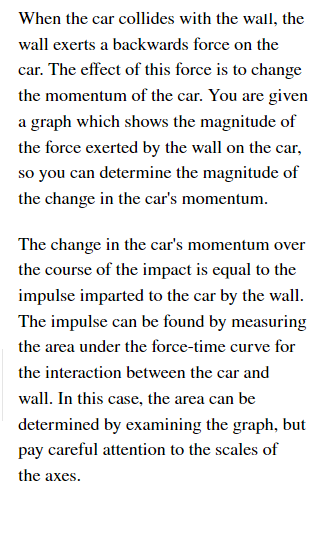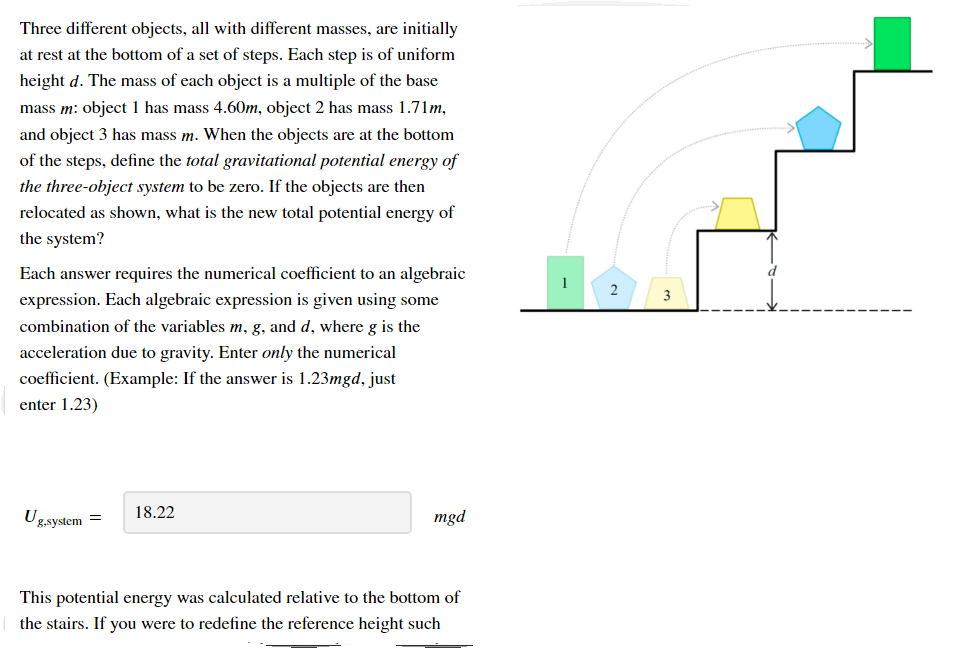Three different objects, all with different masses, are initially at rest at the bottom of a set of steps. Each step is of uniform height d. The mass of each object is a multiple of the base mass m: object 1 has mass 4.60m, object 2 has mass 1.71m, and object 3 has mass m. When the objects are at the bottom of the steps, define the total gravitational potential energy of the three-object system to be zero. If the objects are then relocated as shown, what is the new total potential energy of the system? Each answer requires the numerical coefficient to an algebraic expression. Each algebraic expression is given using some combination of the variables m, g, and d, where g is the acceleration due to gravity. Enter only the numerical coefficient. (Example: If the answer is 1.23mgd, just enter 1.23) This potential energy was calculated relative to the bottom of the stairs. If you were to redefine the reference height such that the total potential energy of the syste
Kinematics
A machine is a device that accepts energy in some available form and utilizes it to do a type of work. Energy, work, or power has to be transferred from one mechanical part to another to run a machine. While the transfer of energy between two machine parts, those two parts experience a relative motion with each other. Studying such relative motions is termed kinematics.
Kinetic Energy and Work-Energy Theorem
In physics, work is the product of the net force in direction of the displacement and the magnitude of this displacement or it can also be defined as the energy transfer of an object when it is moved for a distance due to the forces acting on it in the direction of displacement and perpendicular to the displacement which is called the normal force. Energy is the capacity of any object doing work. The SI unit of work is joule and energy is Joule. This principle follows the second law of Newton's law of motion where the net force causes the acceleration of an object. The force of gravity which is downward force and the normal force acting on an object which is perpendicular to the object are equal in magnitude but opposite to the direction, so while determining the net force, these two components cancel out. The net force is the horizontal component of the force and in our explanation, we consider everything as frictionless surface since friction should also be calculated while called the work-energy component of the object. The two most basics of energy classification are potential energy and kinetic energy. There are various kinds of kinetic energy like chemical, mechanical, thermal, nuclear, electrical, radiant energy, and so on. The work is done when there is a change in energy and it mainly depends on the application of force and movement of the object. Let us say how much work is needed to lift a 5kg ball 5m high. Work is mathematically represented as Force ×Displacement. So it will be 5kg times the gravitational constant on earth and the distance moved by the object. Wnet=Fnet times Displacement.
Three different objects, all with different masses, are initially at rest at the bottom of a set of steps. Each step is of uniform height d. The mass of each object is a multiple of the base mass m: object 1 has mass 4.60m, object 2 has mass 1.71m, and object 3 has mass m. When the objects are at the bottom of the steps, define the total gravitational potential energy of the three-object system to be zero. If the objects are then relocated as shown, what is the new total potential energy of the system?
Each answer requires the numerical coefficient to an algebraic expression. Each algebraic expression is given using some combination of the variables m, g, and d, where g is the acceleration due to gravity. Enter only the numerical coefficient. (Example: If the answer is 1.23mgd, just enter 1.23)
This potential energy was calculated relative to the bottom of the stairs. If you were to redefine the reference height such that the total potential energy of the system became zero, how high above the bottom of the stairs would the new reference height be?
Now, find a new reference height (measured again from the bottom of the stairs) such that the highest two objects have the exact same potential energy.


Trending now
This is a popular solution!
Step by step
Solved in 4 steps with 2 images









